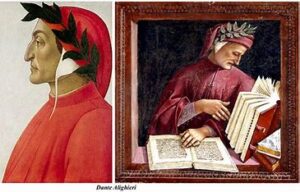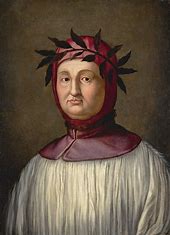SONNET – INTRODUCTION, TYPES, RHYME SCHEME & POETS’
Introduction:
A sonnet is a form of poetry that originated in Italy during the 13th century. The word “sonnet” is derived from the Italian word “sonetto,” meaning “little song” or “little sound.”
Giacomo da Lentini:

Petrarch borrowed the sonnet form from the Sicilian poet Giacomo da Lentini, who is credited with creating the earliest known form of the sonnet in the 13th century. Giacomo da Lentini was part of the Sicilian School of Poetry, a group of poets who wrote in the Sicilian language and played a significant role in developing Italian literature. Petrarch was inspired by the structure and elegance of Giacomo da Lentini’s sonnets, adapting and popularising the form in his poetry.
Petrarch’s Influence:

Through Petrarch’s influence, the sonnet became one of the most celebrated and widely used poetic forms in European literature. Sonnets often explore themes of love, beauty, time, mortality, and human relationships. They provide a structured framework for poets to express complex emotions and ideas within a limited space, making them a popular form of poetic expression throughout literary history. Sonnet as a poetic form was popularised also by Dante Aligheri.
Sonnet comes into England:
The sonnet form was introduced to England by the poet Sir Thomas Wyatt and later popularized by his contemporary, the poet Henry Howard, Earl of Surrey, in the early 16th century. Both Wyatt and Surrey were influenced by the Italian Renaissance poets, particularly Petrarch, and they adapted the sonnet form to the English language. Their translations and imitations of Petrarchan sonnets helped establish the sonnet as a significant poetic form in English literature. Wyatt and Surrey’s contributions paved the way for later English poets, including William Shakespeare and Edmund Spenser, to further develop and refine the sonnet tradition in England.
Sonnet’s first publication in Totell’s Miscellany:
“Tottel’s Miscellany” is one of the most significant literary publications in English literary history. The sonnet was first published in London in 1557, known as “Songes and Sonnettes”. It was published by Richard Tottel, a printer and publisher. “Tottel’s Miscellany” is a collection of poems by various poets of the time, including Sir Thomas Wyatt and Henry Howard, Earl of Surrey.
The collection features a wide range of poetry, including sonnets, songs, and other lyrical works. It played a crucial role in popularizing the sonnet form in English literature
This publication, titled “Songes and Sonnettes,” was a collection of poems by the English poet Henry Howard, Earl of Surrey. It contained several sonnets written in the Petrarchan style, along with other poetic forms. Surrey’s publication of sonnets in London played a significant role in popularizing the sonnet form in English literature during the Renaissance era. In English literature, a sonnet is a poem consisting of 14 lines, typically written in iambic pentameter and following a specific rhyme scheme.
Structure:
- Shakespearean Sonnet (English Sonnet):
- Consists of 14 lines divided into three quatrains (four-line stanzas) followed by a final rhymed couplet (two-line stanza).
- The typical rhyme scheme is ABABCDCDEFEFGG.
- The structure often involves a progression of thought or argument across the quatrains, leading to a conclusion or twist in the final couplet.
- Petrarchan Sonnet (Italian Sonnet):
- Also comprises 14 lines but is divided into an octave (eight lines) followed by a sestet (six lines).
- The octave typically follows the rhyme scheme ABBAABBA, while the sestet can vary with schemes like CDCDCD or CDECDE.
- The structure often presents a problem, question, or situation in the octave, with the sestet providing a resolution, commentary, or contrasting viewpoint.
- Rhyme Scheme:
- Shakespearean Sonnet:
- Employs a more complex and varied rhyme scheme : Three Quatrains and a Coulpet.
- Offers more opportunities for internal rhyme and variation in sound patterns.
- Petrarchan Sonnet:
- Features a simpler and more structured rhyme scheme, particularly in the Octave and Sestet.
- The rhyme scheme helps in creating a clear distinction between the two parts of the sonnet.
- Volta (Turn):
- Shakespearean Sonnet:
Aspect Shakespearean Sonnet (English Sonnet) Petrarchan Sonnet (Italian Sonnet) Structure 14 lines divided into 3 quatrains and 1 couplet 14 lines divided into 1 octave and 1 sestet Rhyme Scheme ABABCDCDEFEFGG ABBAABBACDCDCD or ABBAABBACDECDE Volta (Turn) Often occurs at the start of the third quatrain or within the final couplet Typically occurs between the octave and sestet Thematic Approach Common themes include love, time, mortality, beauty, and human relationships Common themes include love, beauty, and philosophical inquiry; may reflect specific cultural or historical contexts - Shakespearean Sonnet:
- The volta, or thematic shift, often occurs at the start of the third quatrain or within the final couplet.
- This turn can introduce a new perspective, resolve a conflict, or provide a surprising twist to the preceding lines.
- Petrarchan Sonnet:
- The volta typically occurs between the octave and sestet.
- It marks a shift in thought, emotion, or argument, guiding the reader from the problem or question presented in the octave toward its resolution or commentary in the sestet.
Sonnets written for their Lady Love or Patron:
Here are the names of some poets who wrote sonnets for their lady love or patron:
- William Shakespeare: Shakespeare’s sonnets, a collection of 154 poems, are largely focused on themes of love, beauty, and the passage of time. Many scholars believe that the sonnets were addressed to a young man, often referred to as the “Fair Youth,” and a mysterious dark-haired woman, known as the “Dark Lady.”
- Petrarch (Francesco Petrarca): Petrarch, an Italian poet of the 14th century, is often credited with popularizing the sonnet form. His collection of 366 sonnets, known as the “Canzoniere” or “Rime Sparse,” is primarily dedicated to his unrequited love for a woman named Laura.
- Elizabeth Barrett Browning: Browning, an English poet of the Victorian era, wrote a famous sequence of 44 sonnets titled “Sonnets from the Portuguese.” These sonnets were written during her courtship with fellow poet Robert Browning and express her deep love and devotion to him.
- Dante Alighieri: Dante, an Italian poet best known for his epic work “The Divine Comedy,” also wrote sonnets addressed to his beloved Beatrice. Beatrice serves as Dante’s guide through the Divine Comedy, and his sonnets to her express both admiration and spiritual devotion.
These poets used the sonnet form as a vehicle to express their deepest feelings and emotions towards their loved ones or patrons, contributing to the rich tradition of sonnet writing in literature.
Conclusion:
In summary, while both Shakespearean and Petrarchan sonnets share the same basic structure of 14 lines, their differences lie in rhyme scheme, volta placement, and thematic approaches, offering poets distinct tools for poetic expression.
Sonnet writing allows poets to explore themes, emotions, and ideas within a structured framework, challenging them to express depth and complexity within the constraints of a defined form. Throughout literary history, poets from various cultures and languages have employed the sonnet form to convey love, loss, beauty, mortality, and myriad other human experiences.
